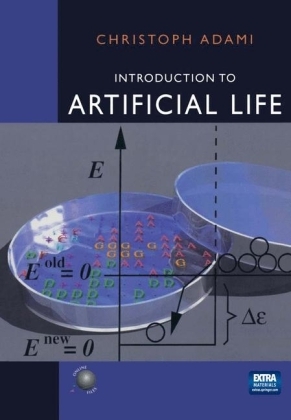
Introduction to Artificial Life
Seiten
1997
|
1998. Corr. 2nd Printing ed.
Springer-Verlag New York Inc.
978-0-387-94646-7 (ISBN)
Springer-Verlag New York Inc.
978-0-387-94646-7 (ISBN)
- Keine Verlagsinformationen verfügbar
- Artikel merken
Useful for students, researchers and professional scientist wanting to gain insight into the frontiers of artificial life, this work provides the basic underpinnings for understanding this interdisciplinary research area. The accompanying CD-ROM invites readers to experience artificial evolution in "real time."
Life is so diverse and complex that is seems impossible to extract the general principles governing each individual living system. Fortunately, however, the unrelenting growth of the power of modern computers has opened up entirely unexpected avenues of opportunity for us in exploring the construction of artificial living systems. This has created the possibility to design and conduct dedicated experiments with these systems, and has generated interest in the idea of formulating a set of "general principles of the living state" which are quite independent of a particular implementation. Such a "theory of living systems" might equally well-predict the outcome of experiments performed on the protean living system which gave rise to life on earth, e. g. , and RNA world, and those worlds in which information is coded in binary strings compiled to programs that have the ability to self-replicate: thus and instance of "Artificial Life. " This book and CD-ROM have been developed in a lab-oriented course taught at Cal Tech in 1995 and 1996, and simultaneously augmented by Artificial Life research conducted there.
The courses have been attended by an interdisciplinary group of students from backgrounds in physics, computer science, and the computational neural sciences. Pre- requisite understanding of statistical physics and thermodynamics, basic biology, as well as familiarity with computer architectures and scientific computing techniques are assumed. This project is an attempt to bring together the necessary theoretical groundwork for understanding the dynamics of systems of self-replicating information, as well as the result from initial experiments carried out with artificial living systems based on this paradigm.
Life is so diverse and complex that is seems impossible to extract the general principles governing each individual living system. Fortunately, however, the unrelenting growth of the power of modern computers has opened up entirely unexpected avenues of opportunity for us in exploring the construction of artificial living systems. This has created the possibility to design and conduct dedicated experiments with these systems, and has generated interest in the idea of formulating a set of "general principles of the living state" which are quite independent of a particular implementation. Such a "theory of living systems" might equally well-predict the outcome of experiments performed on the protean living system which gave rise to life on earth, e. g. , and RNA world, and those worlds in which information is coded in binary strings compiled to programs that have the ability to self-replicate: thus and instance of "Artificial Life. " This book and CD-ROM have been developed in a lab-oriented course taught at Cal Tech in 1995 and 1996, and simultaneously augmented by Artificial Life research conducted there.
The courses have been attended by an interdisciplinary group of students from backgrounds in physics, computer science, and the computational neural sciences. Pre- requisite understanding of statistical physics and thermodynamics, basic biology, as well as familiarity with computer architectures and scientific computing techniques are assumed. This project is an attempt to bring together the necessary theoretical groundwork for understanding the dynamics of systems of self-replicating information, as well as the result from initial experiments carried out with artificial living systems based on this paradigm.
Preface * Contents of the CD-ROM * Flavors of Artificial Life * Artificial Chemistry and Self-Replicating Code * Introduction to Information Theory * Statistical Mechanics and Thermodynamics * Complexity of Simple Living Systems * Self-Organization to Criticality * Percolation * Fitness Landscapes * Experiments with avida * Propagation of Information * Adaptive Learning at the Error Threshold * Appendix A: The avida User's Manual * References * Index.
| Reihe/Serie | TELOS, The Electronic Library of Science |
|---|---|
| Zusatzinfo | 103 illus. |
| Verlagsort | New York, NY |
| Sprache | englisch |
| Themenwelt | Informatik ► Theorie / Studium ► Künstliche Intelligenz / Robotik |
| Naturwissenschaften ► Physik / Astronomie ► Astronomie / Astrophysik | |
| Naturwissenschaften ► Physik / Astronomie ► Theoretische Physik | |
| ISBN-10 | 0-387-94646-2 / 0387946462 |
| ISBN-13 | 978-0-387-94646-7 / 9780387946467 |
| Zustand | Neuware |
| Haben Sie eine Frage zum Produkt? |
Mehr entdecken
aus dem Bereich
aus dem Bereich
Buch | Hardcover (2012)
Westermann Schulbuchverlag
34,95 €
Schulbuch Klassen 7/8 (G9)
Buch | Hardcover (2015)
Klett (Verlag)
30,50 €
Buch | Softcover (2004)
Cornelsen Verlag
25,25 €


